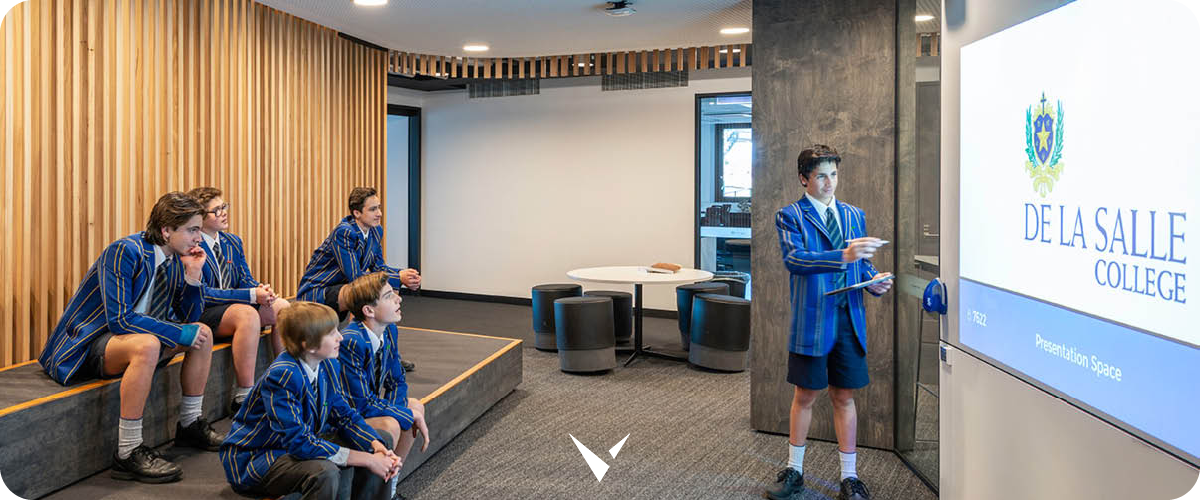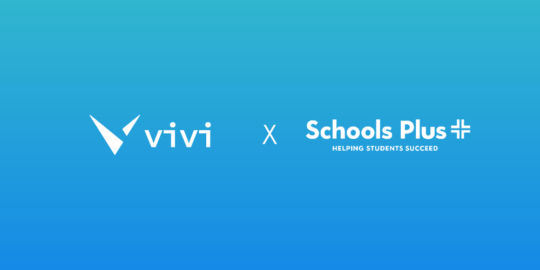
De La Salle College had already unlocked the ROI of its 100 Vivi units. The teachers had embraced the system and were wirelessly presenting all manner of media in the classroom. But ICT Manager, Alex Zolkover, still inspired by a very early demonstration of a Vivi system, knew it could also solve a challenge with communication in the school.
The Challenge
With 1060 students from year-5 to year-12 and spread over 3 campuses, the school needed to find a way to communicate regular and relevant messages to all.
The Outcome
Vivi’s Digital Signage feature brought tailored messaging to different campuses, year groups and blocks, without the need for any additional investment.
With the help of Vivi, De La Salle College has been able to:
1. Bring the right messages to the right students at the right time
The school is pushing relevant and timely messages out to students across all three of its campuses, to update on important information, reinforce the school values and even provide study tips.
2. Manage COVID-related messaging
Because it had already been using the Vivi digital signage module to display Digital Daily Notices in the classroom, the school was able to quickly display COVID-19 safe messages in all classrooms to remind students about the need for face masks, hand washing and social distancing.
3. Improve its return on investment even further
Vivi was already unlocking the benefits it had promised. Using it to solve another problem meant the school didn’t need to implement additional systems or update screens. The Vivi platform simply delivered an even greater return.
“Different areas need different messages. It’s difficult for Year-12 students to be interested in what’s happening in the year-9 campus, 7 km away.”
Alex Zolkover, ICT Manager, De La Salle College
Challenge
When Alex Zolkover arrived at De La Salle College—a Catholic private school for boys in years 5-12 in Melbourne’s south-east suburbs—Vivi was already widely in use. It was technology he was familiar with, having met founder Lior Rauchberger in the company’s early days, while he was at a previous school. Even then, Zolkover was excited about the possibilities it would bring to the classroom.
Originally, the school implemented the system to standardise wireless presentation capacity across the classrooms and common areas of its three campuses, and by the time Zolkover commenced as ICT Manager, the 100 Vivi units were delivering exactly what was promised: the Vivi units were fully embedded into the learning environment, and the teachers freed by wireless technology to get in and amongst their students. Rather than invest in new displays, the school had been able to install units on existing projectors, electronic whiteboards, and televisions, which saved the need for significant further investment.
But Zolkover felt the Vivi system had even more to give. When the screens, projectors and digital whiteboards were not in use, the displays were only showing a school banner. He saw the opportunity to use them to communicate tailored messages to students, teachers, and public alike. Until then, the school had been producing daily notices in a pdf. format and uploading them to the intranet. The expectation was that teachers would pick out relevant content and make sure it was communicated to students. Not all of the information applied to every age group; the needs of year-5 students are, after all, very different from those in year 12. Having teachers filter out messages that were not relevant, meant there was a risk that information would not be distributed consistently.
It was clear that this was a process that could be enhanced significantly by adding a digital component.
Solution
Zolkover knew Vivi was the perfect medium to push notices out to the classroom. The teaching and administrative staff were already using—and benefiting from the system—and, with no additional cost or need to implement new technology, it was an obvious solution.
Vivi’s ability to group classrooms and campuses in a multitude of different configurations freed the school to deliver tailored digital messages to a specific audience. By providing students with appropriate messages in a way that they already found engaging and familiar, the school knew it would improve the likelihood that those who were targeted with a message, would receive it.
The only potential issue in using the boards this way was the need to avoid distracting students in the classroom. To trial various approaches, Zolkover worked with the school librarian to test content. The speed and enthusiasm with which she embraced the trial, gave him even more confidence that Vivi was the right tool for broadcasting important messages.
Result
Since October 2019, the school has been using Vivi’s Digital Signage module to communicate messages whenever the display is on and the teacher is not presenting. The daily notices have become the Digital Daily Notices, and each screen in the school gently cycles through the key messages throughout the day, so as not to distract the students. And the feedback has been excellent; both students and teachers are more likely to see and pay attention to the information they see in the classroom because it’s right in front of them.
The digital content is targeted to each campus, so the year 9 students, for example, don’t receive the same messages as those in the primary school. In another example, students in the science area see the periodic table and other science-focused material, such as the flexibility of the system. The ability to delegate control of the Vivi units means the content is updated at the various campuses each day, by the P.A.s, who are in a far better position to decide which content is appropriate to their audience than the ICT Team.
Using the Vivi units in this way has also brought other opportunities. The ability to schedule messages means that, in addition to the daily digital news, the classroom screens can be used to reinforce school values, provide study tips and promote fundraising events. In common areas, like the library and reception areas, the Vivi units are used to inform a different audience. Freed from the need to balance the avoidance of distraction and the communication of information, the screens in these areas show more dynamic media, such as videos.
Of course, the advent of a global pandemic has seen the school use digital noticeboards in a way it had not originally planned. Students returning to the learning environment for what is virtually the first time after 6-months of home learning are now reminded on a regular basis to wear masks, wash their hands, and social distance.
Advice for Others
Twelve successful months after first using Digital Signage, Alex Zolkover has the following tips for anyone interested in following in De La Salle College’s footsteps:
- Be as creative as you can with your messaging, but keep it simple.
- If you already have a display device in your classroom, there’s no need to invest in another one. You just need a Vivi unit to bring it to life.
- Vivi has so many features. Keep thinking about innovative ways to use what you already have.
- Finally, take the time to talk to Vivi. By telling Vivi what you need, they’ll be able to look at whether there’s an existing way for the system to help you, or whether it’s something they should consider for a future release.



